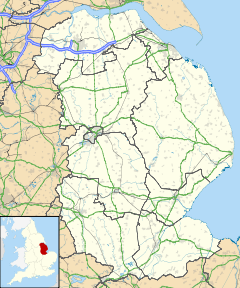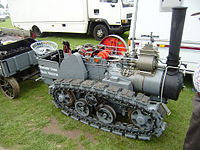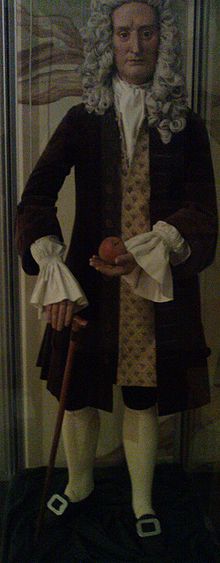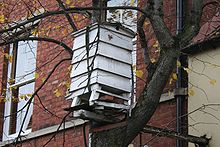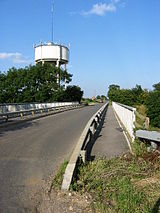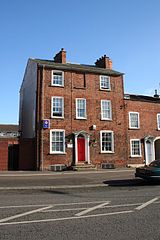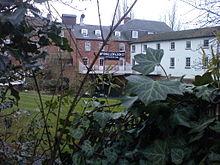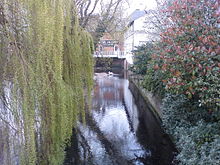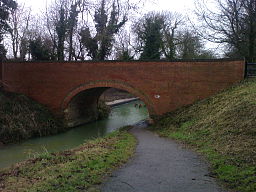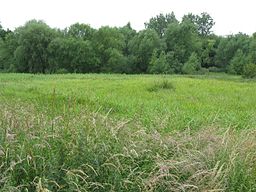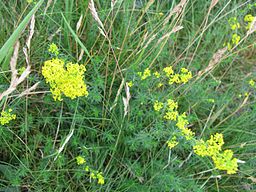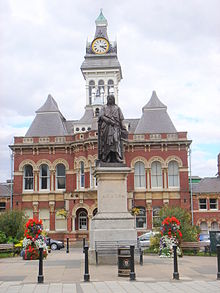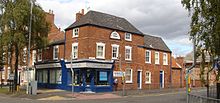- Grantham
-
For other uses, see Grantham (disambiguation).
Coordinates: 52°55′05″N 0°38′17″W / 52.918°N 0.638°W
Grantham 
Grantham as seen from the nearby hills and hollows.
Coat of arms of the former Grantham Borough Council
 Grantham shown within Lincolnshire
Grantham shown within LincolnshirePopulation 34,592 (2001) OS grid reference SK9136 - London 112 mi (180 km) Parish Grantham District South Kesteven Shire county Lincolnshire Region East Midlands Country England Sovereign state United Kingdom Post town GRANTHAM Postcode district NG31 Dialling code 01476 Police Lincolnshire Fire Lincolnshire Ambulance East Midlands EU Parliament East Midlands UK Parliament Grantham and Stamford Website South West Lincs List of places: UK • England • Lincolnshire Grantham is a market town within the South Kesteven district of Lincolnshire, England. It bestrides the East Coast Main Line railway (London-Edinburgh), the historic A1 main north-south road, and the River Witham. Grantham is located approximately 26 miles (42 km) south of the city of Lincoln, and approximately 24 miles (39 km) east of Nottingham. The resident population at the 2001 census was 34,592[1] in around 18,000 households, excluding the adjacent village of Great Gonerby. With the housing estates in Londonthorpe and Harrowby Without (around a population of 4,500), this figure would be around 42,000.
The town is best known as the birthplace of former prime minister Margaret Thatcher, and the place where Isaac Newton went to school. It is close to an ancient Roman road, and was the scene of Oliver Cromwell's first advantage over Royalists during the English Civil War at Gonerby Moor. Grantham is also notable for having the first female police officers in the United Kingdom, in 1914, and producing the first running diesel engine in 1892, and the UK's first tractor in 1896.
Geography
The town boundary crosses the A1 to the west at the Dysart Road bridge. North of there it lies to the east of the A1. It crosses the B1174 at Gonerby Hill. All of the Manthorpe estate is a part of the town, but the (smaller) Manthorpe village and the church are part of Belton and Manthorpe. The boundary then follows Green Lane, bordering the parish of Harrowby. It passes to the west of Harrowby Hall and over Hall's Hill. It then crosses the A52 at the start of Somerby Hill, borders Little Ponton and crosses the B1174 at the southern end of the Spittlegate Level Industrial Estate.
History
Grantham Museum is on St Peter's Hill.
Toponymy
The origin of the name "Grantham" is uncertain, though is said to probably be Old English language "Granta+ham", meaning "Granta's village", and appeared as early as 1086 in the Domesday Book in its present form of Grantham.[2] The Roman name for the river Witham was "Granta".
Prehistory
Late neolithic vessels from a burial were found at Little Gonerby, in the north of the town, in 1875.[3]
Domesday
- In Grantham Queen Edith had 12 carucates to the geld. There is no arable land outside the vill. Queen Edith had a hall, and 2 carucates and land for 3 ploughs without geld. 111 burgesses. Ivo has one church and four mills rendering 12s and eight acres of meadow without geld. The land of Bishop Osmond. In Londonthorpe ... is land for two ploughs. this land belongs to the church of Grantham. In Spittlegate St. Wulfram of Grantham has half a carucate of land to the geld. In Great Gonerby, St. Wulfram of Grantham has 1 carucate of land. there is land for twelve oxen.[4]
Middle ages
In 1363 Grantham Castle was granted to Edmund of Langley, 1st Duke of York, and fifth son of Edward III of England, It was north-east of St Wulframs, and has its legacy in the naming of Castlegate.
Grantham received its Charter of Incorporation in 1463.
Development
The town developed when the railway came to the town. The Nottingham line (LNER) arrived first in 1850, then the London line (GNR) - the Towns Line from Peterborough to Retford - arrived in 1852. The Boston, Sleaford & Midland Counties Railway arrived in 1857.
Until the 1970s the housing estates west of the town centre were green fields. Green Hill, on the A52, was literally a green hill.
Military history
 Army training base on the side of the A52
Army training base on the side of the A52
Dambusters
During the famous Dams Raids Royal Air Force (RAF) mission in May 1943, the RAF Bomber Command's No. 5 Group and the operation HQ was in St Vincents,[5] a building which later housed a district council planning department. It was built by Richard Hornsby in 1865, lived in by Richard Hornsby's son, and is now a private house. In 1944 (including D-Day), this was the headquarters for the USAAF's Ninth Air Force's IX Troop Carrier Command, being known as Grantham Lodge.[6] During the early part of the war Sir Arthur Harris, 1st Baronet lived in the town.
RAF Spitalgate
RAF Spitalgate trained pilots during both world wars, initially as a Royal Flying Corps establishment, but has never been an operational fighter or bomber base; although it did see operational service during the 1943 invasion of Europe as a base for American and Polish gliders and parachutists. It officially closed in 1974. The WRAF had been there since 1960, and moved to RAF Hereford (now the home of the SAS).
RAF Spitalgate is now a Territorial Army (RLC) barracks called Prince William of Gloucester Barracks. Grantham College use the site for football development.[7] The large mast on the base was part of the BT microwave network.
RAF Regiment
The RAF Regiment was formed just north east of the town in parts of Londonthorpe and Harrowby Without during December 1941 with its headquarters at RAF Alma Park which is recognised as the birthplace of the Corps.[8] The Alma Park and Belton Park estates had jointly also been the training centre for the Machine Gun Corps from November 1915.[9] In total Harrowby Camp as it was known housed 18,000 men during World War I.
The RAF Regiment quickly grew to in excess of 66,000 personnel and during training they were housed at RAF Belton Park which was the Regiment's first depot, RAF Folkingham and RAF North Witham. The RAF Regiment stayed until August 1946, when they left for RAF Catterick.
Women's police force
Grantham is notable as being the first place in the world to recruit and train women police officers. Grantham was the first provincial force to ask the newly formed Women’s Police Service to supply them with occasional policewomen, recognising them as particularly useful for dealing with women and juveniles. In 1915, Grantham magistrates swore in Mrs Edith Smith, making her the first proper policewoman in Britain with full powers of arrest.
Industrial history
Hornsby's and their inventions
In 1905 Richard Hornsby (1790-1864) & Sons of Grantham (founded 1815) invented the revolutionary caterpillar track, for use with Hornsby's oil engines; these engines were developed by Yorkshireman Herbert Akroyd Stuart, from which compression-ignition principle the diesel engine evolved, being manufactured in Grantham from 8 July 1892.[10] Although these engines were not wholly compression-ignition derived, later in 1892 a prototype high-pressure version was built at Hornsby's, developed by Thomas Henry Barton OBE - later to be the founder of Nottingham's Barton Transport, whereby ignition was achieved solely (100%) through compression; it ran continuously for six hours, being the first known diesel engine. In the town, Hornsby's built Elsham House (the grounds became Grantham College) and the Shirley Croft. Their site on Houghton Road was bought from Lord Dysart.
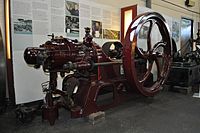 Hornsby oil engine at the Museum of Lincolnshire Life
Hornsby oil engine at the Museum of Lincolnshire Life
In 1909, Hornsby's showed the British Army their invention, who were bemused, but took the idea no further than that, although they subsequently bought four caterpillar tractors in 1910 to tow artillery. A short time later, Hornsbys sold the patent for the caterpillar track in 1914 to The Holt Manufacturing Company of California, USA for $8,000, having only sold one caterpillar tractor commercially.[11] Hornsby's design was far ahead of anything else around at the time. Thanks to the ownership of the patent, this company would become the world-dominating Caterpillar Inc. Tractor Company. Benjamin Holt even claimed to be the real inventor. In December 1914 the British Army's Colonel Ernest Swinton saw one of Holt's caterpillar tractors towing a piece of artillery, and realised its ground-breaking potential as an attack vehicle. One year later the tank was born (using Hornsby's initial designs), being made in nearby Lincoln by William Foster. It first saw action at the Battle of Flers-Courcelette on 15 September 1916.
In 1918 Hornsby's amalgamated with Rustons and the company became Ruston and Hornsby. In the 1920s the company had their own orchestra in the town; the site was a diesel engine plant. Later during World War II, the company would make tanks such as the Matilda at the Grantham factory. R & H left in 1963 and most of the factory was taken over by a subsidiary, Alfred Wiseman Gears, who left in 1968.
Scale model of Hornsby 1910 steam caterpillar tractor
Barford's
Aveling & Porter of Rochester, Kent, would join with Barford & Perkins of Peterborough to become Aveling-Barford Ltd in 1934, largely due to financial help from Ruston & Hornsby, when both companies had entered administration. The new company took a former site of Hornsbys, naming it the 'Invicta' works, from the motto on the coat of arms of Kent, and translates as 'unconquered'; all of Aveling & Porter's machinery was brought from Kent via the train.
During the 1970s it was the town's largest employer with around 2,000 employees.[12][13] It initially prospered but with the sinking market for large dumper trucks and road rollers declined. Their agricultural division was based at Belton, which in 1947 developed the world's smallest tractor, the Barford Atom, weighing 177 lbs.
Now as Barford Construction Equipment, it makes dumpers for construction sites, being owned by Wordsworth Holdings PLC, owned in turn by the entrepreneur Duncan Wordsworth until it went into administration.[14][15] In March 2010, Wordsworth Holdings went into administration. A restructuring package resulted in ownership transferring to Bowdon Investment Group in May 2010, and is known as Invictas Engineering.[16]
A trailer company, Crane-Fruehauf, moved into part of the factory, from its former home of Dereham, when it went into receivership in early 2005.[17]
BMARC
British Manufacture and Research Company (British Marc Ltd or BMARC), on Springfield Road, made munitions notably the Hispano cannon for the Spitfire and Hurricane from 1937 onwards. It was owned by the Swiss company Oerlikon from 1971 until 1988, becoming part of Astra Holdings plc then being bought by British Aerospace in 1992, who then closed the site. It has now been developed as a housing estate. The site's former offices are now business units for the Springfield Business Centre. Grantham's register office was moved there in 2007, due to the catering service being up to wedding reception standard, and Berketex Bride (a national company) is based there.
Traditions
Many traditions have taken place over the years, many of which have been forgotten. There is the Grantham Parade and the Grantham Festival both of which take place every year. There used to be an annual pig drive through the centre of the town until 1962, when it was deemed too dangerous; this tradition dated back to 1755, when pig farmers from the area used to move pigs to greener pastures.
The annual Kesteven Schools Speech and Drama Festival was held in the town.
Gingerbread
The town is known for its Gingerbread biscuits. During the old coaching days Grantham was one of the stopping places of the Royal Mail Coach and while the horses were being changed at the George Hotel, passengers would stroll down the street and invariably purchase a supply of Grantham Whetstones, which were the first form of biscuits ever offered for sale. Then in 1740, a local tradesman, named William Egglestone, made an accidental discovery. In bygone days business premises were always closely shuttered and as part of Egglestone's business was that of a baker, he went into his shop one Sunday morning to procure the ingredients for making some cakes for his family's consumption but in the semi darkness of the shop, he mistook one ingredient for another and it was not until the cakes were baking that he discovered his mistake. The little cakes before being placed in the oven, were cut out with a wine glass and should have remained that size when baked, but instead of which they rose up and became nearly twice the size. Anyway he ventured to taste them, as also did members of his family and they were pronounced most excellent and of a very delicate flavourn afterwards offering them for sale in his shop under the name of Grantham Gingerbreads. Their fame spread north and south of the Great North Road which soon spelt prosperity for Mr. Egglestone whose recipe was passed to his successors, the present day Catlins whose premises still occupy the original shop erected on High Street in 1560.
Local economy and retail
The food-processing industry, with Grantham Hospital, is currently the largest employer of Grantham's population; in town this included Fenland Foods (part of Northern Foods) on the Earlesfield Industrial Estate, which was mothballed in September 2008 following the loss of business with Marks and Spencer, their sole customer;[18] and Moypark (formerly Padleys) in Gonerby Hill Foot.
Seven miles from Grantham at Easton there are two large facilities. The first is Norbert Dentressangle who bought Christian Salvesen Plc in November 2007 and have maintained the frozen storage and distribution operation which has been at the site since the late sixties. The second is McCain Foods who purchased Potato Allied Services (PAS) in 1991 who had run a potato processing factory on site since the early seventies. This has since been extended to include a dedicated Fries-To-Go factory. There was a third large frozen vegetable processing factory owned and operated by Christian Salvesen. However this was sold to Pinguin Foods in August 2007[19] who closed the facility in December 2008.[20] Brake Bros Ltd have a depot near the Gonerby Moor service station, off the B1174.
 Spittlegate Level (B1174) - the former A1 south of the town, home of many local companies and the former Corus Service Centre
Spittlegate Level (B1174) - the former A1 south of the town, home of many local companies and the former Corus Service Centre
Bell & Webster[21] are a nationally-known company, part of Eleco plc[22] based in Ware, that makes precast concrete. Escritt Barrell Golding[23] a local Chartered Surveyors and Estate Agents still operate within the town, having been founded in 1860. Jourdan plc[24] is based in the town which since 1973 has owned John Corby ltd.,[25] the maker of the Corby Trouser Press. There is also Litcomp plc.[26] The Woodland Trust is based on Dysart Road. Natural England had one of their two Lincolnshire offices on Wharf Road until early 2009. There is a small FM radio transmitter near the town's bypass on Gorse Lane from which BBC Lincolnshire is broadcast on 104.7 and Lincs FM on 96.7, and national radio. The transmitter has five staff permanently on site. Most television comes from Waltham, between the town and Melton, due to the line of sight to Belmont being blocked by hills to the east of the town. Grantham now has a full time community radio station Gravity FM which broadcasts on 97.2 and online at Gravityfm.net[27] Amberjac Projects is the only European company that provides plug-in conversion for conventional hybrid vehicles.[28][29] Rapstrap has recently been sued for patent infringement. Grantham Engineering is on Harlaxton Road.[30] The town has one of the only three branches of the Melton Mowbray Building Society.
Hotels
The conference and hospitality industry are well represented in the Grantham area, with the Olde Barn Hotel in Marston, the De Vere Belton Woods Hotel, the Ramada Grantham and various golf clubs. Stoke Rochford Hall staged a Lib Dem education conference in 2001.
Business meetings are often held at the Ramada on Swingbridge Road (near the A1/A607 junction), the Olde Barn at Marston, and also at the EM Learning Centre on Londonthorpe Road.[31]
Closures
Brook Street and Hill Avenue sub post offices were closed in Grantham in 2008 as part of the Post Office Network Change programme. In August 2010, it was confirmed that the Grantham branch of Marks and Spencer would close, along with two other Lincolnshire branches in Skegness and Scunthorpe, due to low sales. The closure had been met with protests from the local community.[32] Part of the reason for low footfall in shops is the time taken to get in and out of Grantham by car. Haldanes, a chain of around 20 supermarkets, based as far north as Scotland and based on Ruston Road, went into administration
Governance
Grantham once lay within the ancient Winnibriggs and Threo wapentake in the Soke of Grantham in the Parts of Kesteven.
Politically the town is part of the Grantham and Stamford constituency and is represented in Parliament by Conservative Party Member of Parliament (MP) Nicholas Boles who was elected in May 2010 after the resignation of Quentin Davies. Davies had been elected to the seat as a Conservative before crossing the floor to join the Labour Party; the constituency has a long history of electing Conservative members of Parliament, and Davies holding the seat for Labour was the subject of much local resentment.
The local authority - South Kesteven District Council - is currently Conservative-led, with the current political makeup being 35 Conservative, 15 Independent, 2 Labour and 6 Liberal Democrat councillors.[33] Before SKDC in 1974, the local area was represented by Grantham Borough Council, based on St Peters Hill, and West Kesteven Rural District, based on Sandon Close; this became the planning department of SKDC. In November 1973 it was decided to make Grantham to headquarters of SKDC, first based in the former offices of Grantham Corporation.
Education
The town is home to Grantham College, a further education college for the district which opened in 1948, for those not attending school sixth forms. It has a satellite site at Sleaford, called Sleaford College. Since September 2008 the Walton Girls High School on Kitty Briggs Lane near Harlaxton Road has offered post-16 courses as Grantham's only sixth form college.
Two notable schools in the district are Kesteven and Grantham Girls' School and The King's Grammar School. Both have large sixth forms and eminent past students. Britain's first female Prime Minister, Margaret Thatcher, attended Kesteven and Grantham, and Isaac Newton famously attended The King's. Both schools achieve high examination results and hold high places in the county's league tables. Both have remained single-sex up to the age of 16.
In 1970, Kesteven County Council (based in Sleaford) announced plans to turn the grammar schools into co-educational comprehensives for ages of 11–16 and leave Grantham College the only sixth form for the town. Later it was proposed to create two sixth-form colleges from one of the grammar schools. Other parts of Kesteven became comprehensive, but the fact that responsibility for education passed to Lincolnshire under the local government reorganization of 1974 meant that both schools staying as grammar schools. Furthermore, ex-pupil Margaret Thatcher was education secretary at the time. The governors of the King's School delayed the process in July 1973, and later a plan to make Grantham comprehensive was voted against by the county council in January 1975, having been approved by the council's own education committee.
All four secondary modern schools are on the outskirts of the town, with the other notable school of this type was the Central Technology & Sports College, a co-educational school near Manthorpe. Central Technology and Sports College became the Priory Ruskin Academy in September 2010. Only three of the six secondary schools are co-educational. For the Grantham area of South Kesteven, around 60% of those at 16 achieve five GCSEs at grades A*-C. This compares to 45% for those in Melton and under 30% for those in Newark in recent years.
Tucked away on Gorse Lane is Grantham Preparatory School, an independent school preparing entrants for the 11-plus examination. There is another private primary school called Dudley House.[34] Next to St Wulfram's is the National Church of England Junior School,[35] built in 1859 and a highly regarded primary school, and proven feeder school for the grammar schools.
The Blessed Hugh More School, a Catholic secondary school, closed in 1989.[36]
Landmarks
The main local landmark is the parish church of St Wulfram's, which has the sixth highest spire (282 ft) among English churches. It is the second tallest church in Lincolnshire after St James Church in Louth, and is also home to the country's first public library. In 1598, Francis Trigge, rector of Welbourn, gave £100 for a small library of books for the clergy and literate laity of Grantham. Two hundred and fifty of the original volumes remain and are kept in the parish church. From October 1974, the church was permanently floodlit at night. The Bishop of Grantham is currently Tim Ellis and has his official residence in Long Bennington.
Grantham House is to the east of the church, and a National Trust property.
Grantham is home to the country's only 'living' pub sign: a beehive of South African bees located outside since 1830. Grantham was the site of an Eleanor Cross, erected by Edward I at each of the resting places of the body of his queen, following her death at Harby, as it was carried to London for burial in 1290. No trace of the cross remains, but is thought to be near St Peters Hill.
 The 1869 Victorian Gothic Guildhall on St Peters Hill designed by William Watkin
The 1869 Victorian Gothic Guildhall on St Peters Hill designed by William Watkin
Edith Smith Way is the name of the road beside the Guildhall Arts Centre, on 'St Peter's Hill'; it is named after England's first policewoman. Miss Mary Allen and Miss Ellen F. Harburn reported for duty on the 'beat' on 27 November 1914, during the First World War.[37] Mary Allen was a former suffragette and had been previously arrested outside the House of Commons and later went on to be the commandant of the UK's women's police force from the 1920s up to 1940. She helped to set up women's police forces in other countries, including Germany. Edith Smith became the first female with powers of arrest in August 1915.[38]
The Angel & Royal Hotel is one of Britain's oldest inns, dating from about 1200.[39] King John held court there in 1213, when the site was a hostel run by the Knights Templar. Richard III signed and sealed the death warrant of the Duke of Buckingham at the inn. It is one of only three Knights Templar hostels in England - another was at Glastonbury.
Sandon Road is named after Viscount Sandon, who is also the Earl of Harrowby. The first person with this title was Dudley Ryder, 1st Earl of Harrowby, and a road is also named after him. He purchased Harrowby Hall in 1754. The current incumbent is Dudley Ryder, 8th Earl of Harrowby.
The George Hotel nearby (known as St Peter's Place, now the George Shopping Centre) was mentioned in Charles Dickens's novel Nicholas Nickleby. Also in the town is the Blue Pig, one of many Blue pubs. Much of the town's property and industrial estates have been owned by Buckminster Trust Estates since the time of the Earl of Dysart.
To the west of the town near the A607 is the building of Baird's maltings (formerly owned by Moray Firth until 1999, and R & W Paul before them). Other maltings in the town have been converted for residential use such as Riverview Maltings near the river and formerly owned by Lee & Grinling’s.
The JobCentre, when it opened in 1975, was the first of its kind.
Grantham and District Hospital can be seen from the train, and is situated next to the Central School on the A607 north of the town. The maternity unit, which opened in August 1972, is now a midwife-staffed unit.
Nearby are many historic houses including 17th-century Belton House, early 19th-century Harlaxton Manor, Stoke Rochford Hall (the training centre of the NUT), and the 11th-century Belvoir Castle (in Leicestershire). Much of the property and land to the south-west of the area, that which is in line of sight of the Waltham transmitter, is owned by the two estates of Belvoir and Buckminster.
Further information: public houses and inns in GranthamTransport
Rail
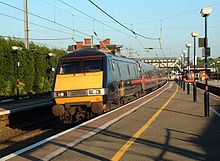 Class 91 electric train at the station in May 2004, looking south
Class 91 electric train at the station in May 2004, looking south
Grantham railway station is served by the London-Edinburgh East Coast Main Line (between the stops for Peterborough and Newark Northgate), and the Nottingham to Skegness Line (Poacher Line). Liverpool-Norwich trains also call at Grantham. The electric trains arrived in October 1988. The good transport links to Nottingham and Peterborough attract people to live in Grantham yet work in a larger city. The town's grammar schools also attract pupils from Radcliffe on Trent, Bingham, Newark and even Retford via the train. Grantham is the best-served station in Lincolnshire, although after October 1970, Lincolnshire's railways were mostly closed. Prior to October 1970, the connection from King's Cross to Lincoln St. Marks was through Grantham and followed the A607 via Leadenham.
In 1906, a rail accident killed 14 people.
Road
The town has the A1 main road from London to Edinburgh running past it (the town was bypassed in 1962). The main shopping High Street, until recently, was part of the busy A52 (which runs to nearby Nottingham), and Wharf Road and London Road (next to Sainsbury's) still are, meeting the A607 (for Lincoln) at a busy junction. There is a motorway-style Grantham North Services at the north end of the bypass, on the new junction which has recently replaced a roundabout in May 2008.[40] It is east-west traffic on the A52 that causes Grantham the most problems, not least to two of its frequently-hit railway bridges. The east-west bypass will cross Spittlegate Level and join the A52 next to the former RAF Spitalgate.
Grantham, with Stamford, had been earmarked for a bypass before the war in 1939. There were 60 serious accidents a year, with 3 to 4 deaths. After the war, on 21 November 1945, there was a meeting at the Guildhall about the proposed bypass of the London-Edinburgh-Thurso trunk road for Grantham and Great Gonerby. This was the first enquiry into a trunk road scheme in the country after the war. The proposed route followed the current line, from Little Ponton to College Farm, except it was to be a single carriageway road.
Some years later, on 8 February 1960, it was announced that bypass would be built, including the route south to Colsterworth. Robert McGregor and Sons Ltd of Manchester would build the road for £1,856,009 (who then built the Newark Bypass in 1964). The bridges were built by Simon Carves of Cheadle Hulme. It was formally opened on 10 October 1962 by James Heathcote-Drummond-Willoughby, 3rd Earl of Ancaster, then the Lord Lieutenant of Lincolnshire (from 1950–75).[41] He was married to the (only) daughter of Nancy Astor.
Waterways
Grantham was once linked to Nottingham by the Grantham-Nottingham canal (the Grantham Canal). Currently the canal is in a state of disrepair, but some sections are undergoing restoration. It is possible to walk along the canal at Harlaxton village.
River Witham at Spittlegate Mill, Grantham
The River Witham runs through Grantham. It has a pleasant and popular riverside walk linking Dysart Park and Wyndham Park. Along this walk it is possible to see an old Mill House. The walk passes an allotment and the rear of Sainsbury's car park (where there is an access point). It is necessary to cross the river at the end of College Street using a pedestrian bridge. The walk can be continued throughout Wyndham Park. There are a number of foot bridges providing a pleasant view of the river and its numerous weirs. Swans, ducks and trout are among the wildlife that can be seen along the river.
Sport
Football
Grantham Town Football Club is the local football team, currently playing in the Evo-Stik League Division One South. The club was founded in 1874 and currently plays in the 7,500-capacity (covered 1,950, seats 750) South Kesteven Sports Stadium (although average attendances are well below capacity).[42] The ground also doubles as the town's athletics stadium (one of only three in Lincolnshire), next to the Grantham Meres Leisure Centre on Trent Road.[43]
The major claim to fame of Grantham Town (nicknamed 'The Gingerbreads') is that Martin O'Neill started his management path from there.[citation needed]
Rugby
Kesteven Rugby Club plays at Woodnook, off the B6403 in Little Ponton.
Hockey
Grantham Hockey Club, which fields two men's teams and one women's team in league hockey, play at the Meres Leisure Centre, the astro-turf pitch situated directly behind the football stadium.[44]
Bowls
Grantham is also well known[citation needed] for its indoor and outdoor bowls players who have represented the clubs within many county and national competitions. Players who have played for the England squad from the indoor club include: Martin Pulling (retired), Dion Auckland (retired), Ian Johnson (retired) and Matthew Orrey (current England U25 player).[citation needed][45]
Nature
Grantham and the surrounding area is home to the Peregrine Falcons which roost in the bell tower of St Wulframs Church, and the Grantham Gobbler, a Heron. Unfortunately both of these birds are voracious predators, which has upset pigeon fanciers and fish lovers. Grantham is surrounded by rolling countryside and woodland, for example the nearby Ponton Park Wood, suitable for country walks with views of the Lincolnshire farmland and woodland. To the south of the town the River Witham flows through a number of marshes and water meadows between Little Ponton and Saltersford. This area is rich in wildlife including herons, ducks, geese, water vole (Arvicola amphibius) and the now critically endangered white clawed crayfish. There are notable populations of dragonflies, especially Aeshna grandis, Anax imperator, Libellula quadrimaculata and Calopteryx splendens in this area and also on the Grantham Canal which winds through The Vale of Belvoir to the west of the town. The countryside around Grantham is also rich in plant life. The water meadows to the south of the town support a rich variety of species including vetches, Cowslip, Primula veris, Lady's bedstraw Galium verum, Southern Marsh Orchid, and several other species of orchid.
Please also see Waterways for further details of the River Witham in Grantham.
Visits to Wyndham Park and Dysart Park offer opportunities to spot local wildlife.
Places for children
Wyndham Park has two children's play areas. One area, adjacent to the cafe and bowling green offers new equipment for children under six years old. There is an open air paddling pool. There is a marked football pitch at Wyndham Park and skateboard park. There is a public toilet available when the cafe is open at the back of the cafe. Dysart Park also has a paddling pool and safe play area for children under six. There is a public toilet close to the paddling pool. The green at Dysart Park is used for football, and a bandstand. It is possible to walk from Dysart Park to Wyndham Park along the River Witham. See Waterways.
Indoor attractions for young children include the swimming pool at the Meres Leisure Centre, the library located in the Sir Isaac Newton Centre, the Grantham Museum; the Guildhall Theatre, activity centres at the Muddle-Go-Nowhere pub off Barrowby Road, and Fun Farm off Dysart Road.
Organisations which encourage the participation of young people include Brownies, Guides and Air Cadets. Theatrical experience is available via the Guildhall Theatre.[46]
Belton House is one of the most popular National Trust sites in the country regular events for children held at Belton House. Its outdoor play area with train rides is popular during high season. In addition to the main house and grounds, there is a picnic area in the children's play zone, and a woodland walk.
The Grantham Journal
Grantham has a newspaper, The Grantham Journal, which first went on sale in 1854 under the name The Grantham Journal of Useful, Instructive and Entertaining Knowledge and Monthly Advertiser, which was shortened to its current name a few years later. The Grantham Journal is owned by Johnston Press and has a sister newspaper in Melton Mowbray, called the Melton Times. In the 1960s, and earlier, it had operated the Melton Journal and Rutland Journal, both versions of the main paper, still produces a separate Bingham edition.
Twin town
 - Sankt Augustin, North Rhine-Westphalia, Germany (near Bonn, 57,000 population), twinned[47] since 1980. The A52 relief road is named Sankt Augustin Way. Sankt Augustin has its Grantham-Allee and "Grantham-Bridge".[48]
- Sankt Augustin, North Rhine-Westphalia, Germany (near Bonn, 57,000 population), twinned[47] since 1980. The A52 relief road is named Sankt Augustin Way. Sankt Augustin has its Grantham-Allee and "Grantham-Bridge".[48]
Notable people
Sir Isaac Newton by William Theed, 1858, bronze; St Peter's Hill, Grantham The house where Margaret Thatcher was born in Grantham
The house where Margaret Thatcher was born in Grantham
- Three world-famous people associated with the town are:
- Isaac Newton, physicist and mathematician
- Thomas Paine, author and revolutionary;
- Margaret Thatcher, politician, daughter of Alderman Alfred Roberts
- Beverley Allitt, serial killer;
- Antonio Berardi, fashion designer;
- Roderick Bradley, American footballer;
- Judy Campbell, actor and playwright;
- Geoff Capes, athlete;
- Eric Chappell, comedy writer
- Johnny Haddon Downes, television producer
- Vince Eager, singer;
- Graham Fellows, actor and musician;[49][50]
- Michael Garner, actor;
- Maxwell Hutchinson, architect;
- Philip Knights, Baron Knights, police officer;
- Graham Lewis, musician;
- Jessie Lipscomb, sculptor;
- Nicholas Maw, composer;
- Henry More, 17th century philosopher;
- Richard Nauyokas, soldier and actor;
- Mark A. O'Neill, biologist and computer scientist;
- Nicholas Parsons, television and radio presenter;
- Norman Shrapnel, political correspondent and author;
- John Still, bishop of Bath and Wells (1593–1608)
- Doris Stokes, spiritualist and psychic medium;
- William Stukeley, antiquarian;[51][52]
- Richard Todd, actor;
- Clare Tomlinson, news presenter;
- Ashley Wright, cricketer;
- Luke Wright, cricketer;
Bibliography
- The Royal Charters of Grantham 1463-1688 Edited by G.H. Martin - Limited to 400 copies and contains list of Charters and index.[53]
References
- ^ "KS01 Usual resident population: Census 2001, Key Statistics for urban areas". Office for National Statistics. http://www.statistics.gov.uk/StatBase/ssdataset.asp?vlnk=8271&Pos=2&ColRank=1&Rank=144.
- ^ Mills, A.D. (1991) "A Dictionary of English Place-Names," Oxford University Press.
- ^ MAY Jeffrey (1976) Prehistoric Lincolnshire page 84, published by History of Lincolnshire Committee
- ^ Domesday. 1086. p. Folio 357v.
- ^ Telegraph.co.uk, St Vincents
- ^ Raymond Harwood. "9th Troop Carrier Command". Publicenquiry.co.uk. http://www.publicenquiry.co.uk/commands/tc9th.html. Retrieved 30 July 2009.
- ^ Grantham.ac.uk
- ^ Birthplace of the RAF Regiment
- ^ "Membership". Machineguncorps.co.uk. http://www.machineguncorps.co.uk/history.html. Retrieved 30 July 2009.
- ^ "Richard Hornsby Vaporizing Oil Engine". Engines.rustyiron.com. 7 December 1910. http://engines.rustyiron.com/hornsby. Retrieved 30 July 2009.
- ^ Google.com
- ^ Aveling Barford Graces Guide
- ^ Aveling Barford
- ^ "Barford". Barforddumpers.com. http://www.barforddumpers.com/HTML/02_about.html. Retrieved 30 July 2009.
- ^ "Wordsworth Holdings plc". Whplc.co.uk. http://www.whplc.co.uk. Retrieved 30 July 2009.
- ^ Invictas Engineering
- ^ "Fruehauf". Fruehauf. http://www.fruehauf.co.uk. Retrieved 30 July 2009.
- ^ Hart, Bob. "Updated: Fenland Foods workers to protest". Grantham Journal. http://www.granthamjournal.co.uk/news/UPDATED-Fenland-Foods-workers-to.4075959.jp. Retrieved 30 July 2009.
- ^ "Christian Salvesen Easton factory sold". Grantham Journal. http://www.granthamjournal.co.uk/news/Christian-Salvesen-Easton-factory-sold.3132220.jp. Retrieved 30 July 2009.
- ^ "All news from the East Midlands". Thisisbusiness-eastmidlands.co.uk. http://www.thisisbusiness-eastmidlands.co.uk/news/lincolnshire/jobs-facing-the-axe-at-food-firm.aspx. Retrieved 30 July 2009.
- ^ Bellandwebster.co.uk
- ^ Eleco.com
- ^ <http://www.ebgproperty.co.uk>
- ^ Jourdanplc.co.uk
- ^ Corbypress.com
- ^ Litcomp-plc.com
- ^ Gravityfm.net
- ^ Amberjaprojects.com
- ^ Calcars.org
- ^ Grantham Engineering
- ^ EM Learning Centre
- ^ BBC New Lincolnshire 25 August 2010 'M&S confirms three store closures in Lincolnshire'. Retrieved 25 August 2010.
- ^ Skdc.com
- ^ Offsted site: Retrieved 19 May 2011.
- ^ National School
- ^ Schools etc. site: Retrieved 19 May 2011.
- ^ "Mary Allen". Spartacus.schoolnet.co.uk. http://www.spartacus.schoolnet.co.uk/Wallen.htm. Retrieved 30 July 2009.
- ^ "UK | England | Lincolnshire | Town remembers first policewoman". BBC News. 13 January 2006. http://news.bbc.co.uk/1/hi/england/lincolnshire/4610200.stm. Retrieved 30 July 2009.
- ^ "Welcome to Ashdale Hotels". Angelandroyal.com. http://www.angelandroyal.com. Retrieved 30 July 2009.
- ^ "Highways Agency - Gonerby Moor Progress Photos". Highways.gov.uk. 1 April 2008. http://www.highways.gov.uk/roads/projects/17538.aspx. Retrieved 30 July 2009.
- ^ Concrete Quarterly 55, page 32
- ^ "South Kesteven Sports Stadium". Runtrackdir.com. http://www.runtrackdir.com/details.asp?track=grantham. Retrieved 30 July 2009.
- ^ "Meres Centre Tickets, Grantham". Ents24.com. http://www.ents24.com/web/venue/23583/Grantham/Grantham_Meres_Leisure_Centre.html. Retrieved 30 July 2009.
- ^ Grantham Hockey Club
- ^ Grantham Bowls Club
- ^ Guildhall Theatre
- ^ Sankt-augustin.de (German)
- ^ "Bonn-Rhein-Sieg University of Applied Sciences - University - Addresses and how to find us - Sankt Augustin by train". Fh-brs.de. 3 March 2009. http://www.fh-brs.de/Sankt_Augustin_by_train-lang-en.html. Retrieved 30 July 2009.
- ^ Graham Fellows: Coronation Street Wiki . Retrieved 29 January 2011.
- ^ Graham Fellows: corrie.net . Retrieved 29 January 2011.
- ^ William Stukeley at Grantham. Retrieved 29 January 2011.
- ^ William Stukeley: Grantham doctor. Retrieved 29 January 2011.
- ^ Detail taken from a copy of The Royal Charters of Grantham 1463-1688 published by Leicester University Press in 1963
Further reading
- Thomas Allen (1834). "Grantham soke and town". The history of the county of Lincoln: from the earliest period to the present time. 2. London and Lincoln: John Saunders Jr. pp. 300–317. ISBN 1142342360.
External links
- Grantham tourist information, business services, community information, youth zone, news. - published by Kesteven District Council
- Grantham Journal Newspaper
- Information on Grantham's history
- Description of the town, street photographs and business directory.
- History of Ruston & Hornsby.
- Grantham Future
- Kesteven RFC
- Gingerbread recipe
- Lincolnshire Life article (PDF)
- The town that made Margaret April 2009
- Let's move to Grantham May 2010
Video clips
- Pathe Newreel, 1927, of flying display at RAF Spitalgate
- Newsreel, 1935. Inaugural run of "Silver Jubilee" Kings Cross-Grantham.
- Proposal for new bypass
- Kelvin MacKenzie tours Grantham Museum
- Mrs Thatcher and Grantham in July 1970
- Grantham Market Place 1836-2007 on YouTube, retrieved 18 Dec 2010
- Grantham streets 01 on YouTube, retrieved 18 Dec 2010
- Grantham streets 02 on YouTube, retrieved 18 Dec 2010
- Grantham from Belton Tower's channel on YouTube, retrieved 18 Dec 2010
Ceremonial county of Lincolnshire Unitary authorities Boroughs or districts Major settlements - Alford
- Barton-upon-Humber
- Boston
- Bourne
- Brigg
- Broughton
- Burgh-le-Marsh
- Caistor
- Cleethorpes
- Crowland
- Crowle
- Epworth
- Gainsborough
- Grantham
- Grimsby
- Holbeach
- Horncastle
- Immingham
- Kirton-in-Lindsey
- Lincoln
- Long Sutton
- Louth
- Mablethorpe
- Market Deeping
- Market Rasen
- North Hykeham
- Scunthorpe
- Skegness
- Sleaford
- Spalding
- Spilsby
- Stamford
- Wainfleet All Saints
- Winterton
- Wragby
See also: List of civil parishes in Lincolnshire
Topics Categories:- Grantham
- Market towns in Lincolnshire
- Towns in Lincolnshire
- South Kesteven
Wikimedia Foundation. 2010.

